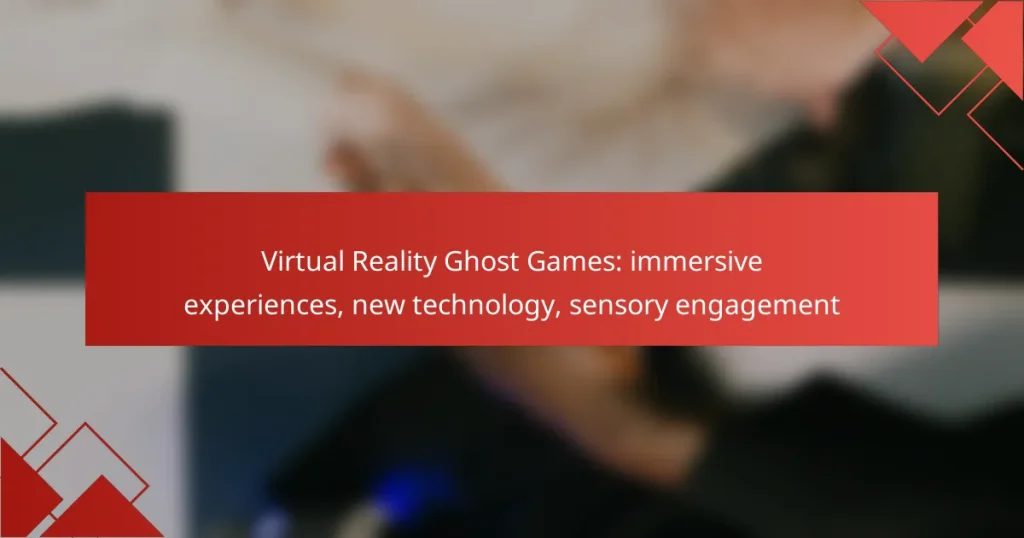Virtual reality ghost games offer players thrilling and immersive experiences that engage multiple senses through cutting-edge technology. By utilizing advanced headsets and motion tracking, these games create chilling atmospheres that heighten emotional responses and excitement, making players feel as if they are truly part of the haunting. Titles like Phasmophobia and Ghost Hunters Corp exemplify this genre, combining unique gameplay mechanics with social interaction to enhance the overall experience.
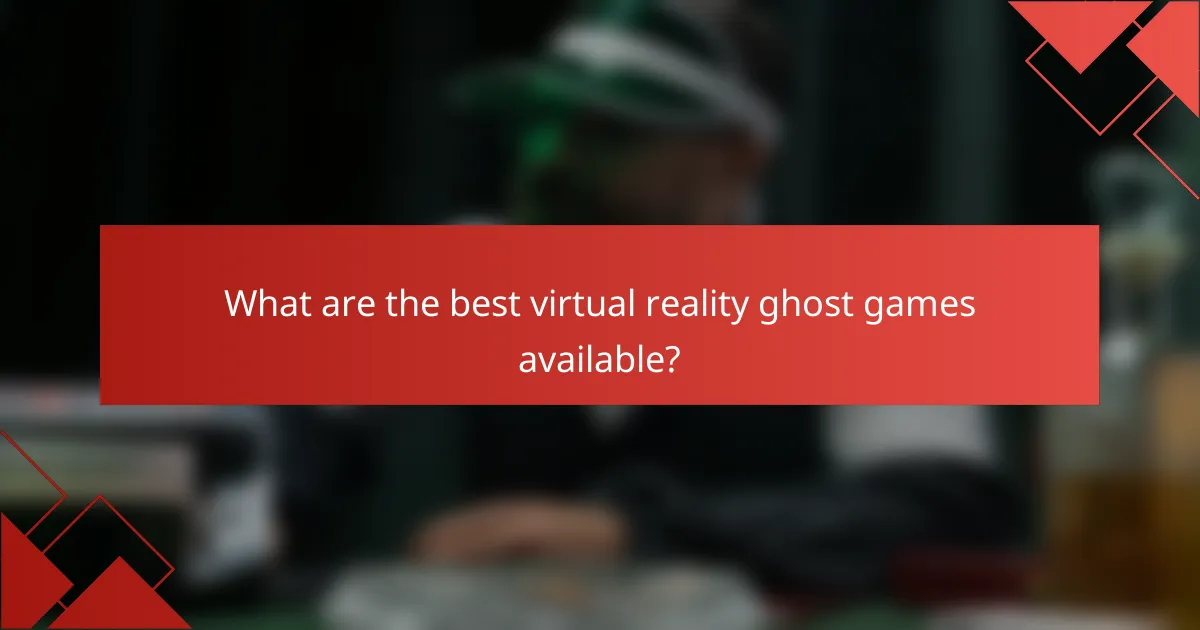
What are the best virtual reality ghost games available?
The best virtual reality ghost games provide immersive experiences that engage players’ senses and emotions, often using advanced technology to create chilling atmospheres. Titles like Phasmophobia and Ghost Hunters Corp stand out for their unique gameplay mechanics and social interaction elements.
Phasmophobia
Phasmophobia is a cooperative horror game where players take on the role of ghost hunters investigating haunted locations. Utilizing VR technology, players can interact with their environment and use various tools to identify different types of ghosts.
Key features include voice recognition, which allows players to communicate with ghosts, and a variety of equipment such as EMF readers and spirit boxes. The game’s reliance on teamwork and strategy makes it a thrilling experience for groups.
Ghost Hunters Corp
Ghost Hunters Corp offers a unique blend of strategy and horror, allowing players to work together to capture ghosts in diverse settings. The game emphasizes teamwork and planning, requiring players to use specific tools and tactics to succeed.
Players can choose from various roles, each with distinct abilities, enhancing the cooperative aspect. The immersive graphics and sound design contribute to a heightened sense of fear and urgency during gameplay.
Dead by Daylight
Dead by Daylight is an asymmetrical multiplayer horror game where one player assumes the role of a killer while others play as survivors trying to escape. Although not exclusively a ghost game, it features supernatural elements and various killers inspired by horror lore.
The game’s blend of strategy, stealth, and action creates a tense atmosphere, making it popular among horror enthusiasts. Players must work together to repair generators and evade the killer, adding layers of strategy to the experience.
Ghost Exile
Ghost Exile is a cooperative ghost hunting game that emphasizes exploration and investigation. Players can choose from different ghost types and utilize various tools to uncover clues and banish spirits.
The game features a variety of maps and ghost behaviors, requiring players to adapt their strategies. Its focus on teamwork and communication enhances the immersive experience, making it a compelling choice for VR enthusiasts.
Spirit Hunters: Infinite Horde
Spirit Hunters: Infinite Horde combines action with ghost hunting, allowing players to battle waves of supernatural entities. The game features a unique progression system where players can upgrade their abilities and equipment as they advance.
With a focus on fast-paced gameplay and engaging mechanics, it offers a different take on the ghost hunting genre. Players must strategize to survive increasingly difficult challenges, making it an exciting option for those seeking adrenaline-fueled experiences.
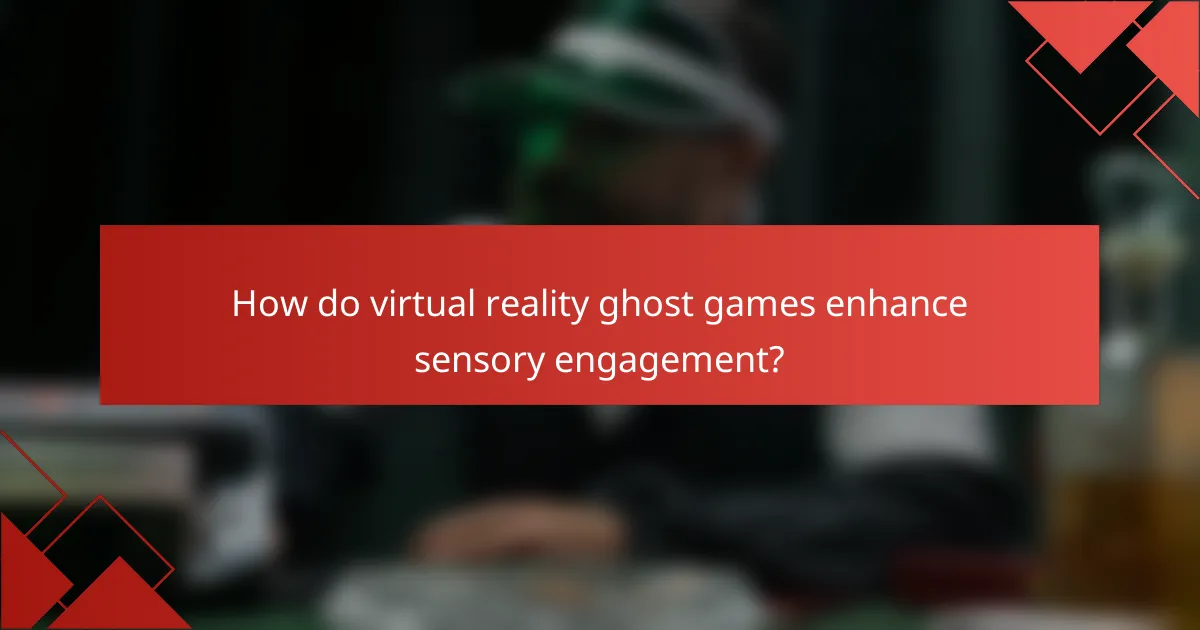
How do virtual reality ghost games enhance sensory engagement?
Virtual reality ghost games enhance sensory engagement by immersing players in a multi-faceted experience that stimulates sight, sound, and touch. This technology creates a compelling environment that feels real, encouraging deeper emotional responses and heightened excitement.
Immersive audio effects
Immersive audio effects play a crucial role in virtual reality ghost games by creating a 360-degree sound environment. Players can hear whispers, footsteps, and environmental sounds that react to their movements, enhancing the feeling of presence. High-quality spatial audio can make it seem as if sounds are coming from specific directions, increasing tension and engagement.
To maximize the audio experience, use headphones that support surround sound. This ensures that players can accurately perceive the location of sounds, which is vital for creating suspenseful moments in the game.
Realistic visual environments
Realistic visual environments are essential for immersing players in virtual reality ghost games. Detailed graphics, lifelike animations, and dynamic lighting contribute to a believable setting that captivates users. Environments often include haunted houses, eerie forests, or abandoned asylums, designed to evoke fear and curiosity.
When developing or choosing a game, consider the quality of the graphics and the level of detail in the environments. Games with high-resolution textures and realistic physics will provide a more engaging experience, making players feel as if they are truly part of the haunted world.
Haptic feedback technology
Haptic feedback technology enhances sensory engagement by providing tactile sensations that correspond with in-game events. This can include vibrations when a ghost appears or subtle feedback when navigating through a spooky environment. Such sensations help to create a more immersive experience, making players feel the tension and excitement physically.
When selecting VR equipment, look for controllers and headsets that offer advanced haptic feedback capabilities. This technology can significantly elevate the emotional impact of ghost encounters, making them more memorable and intense.
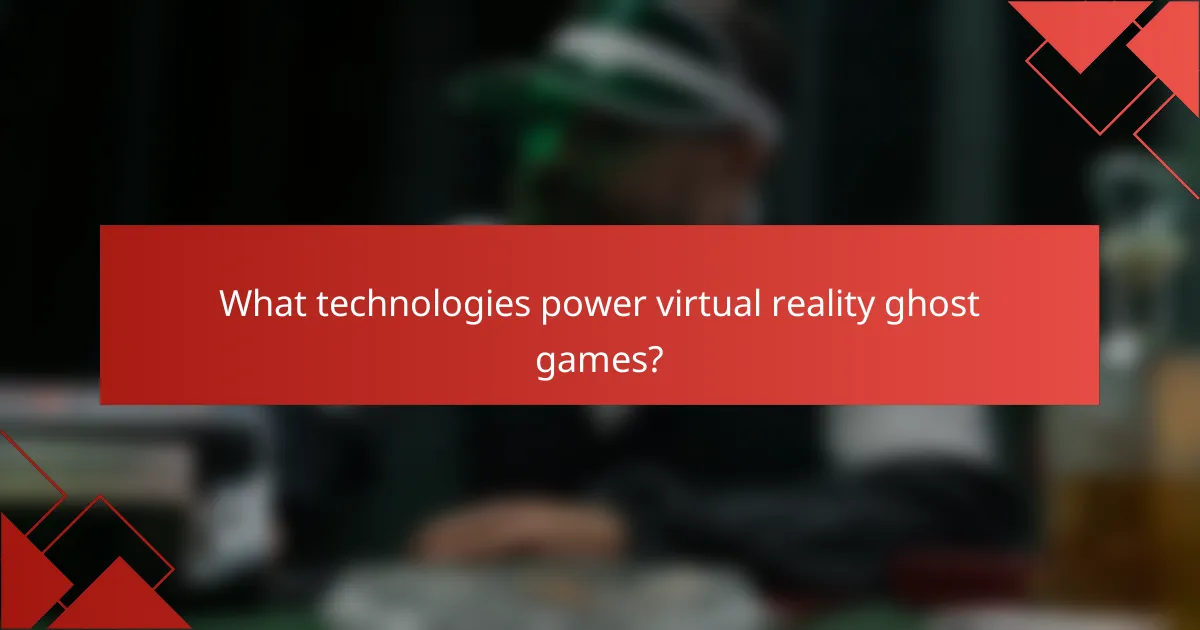
What technologies power virtual reality ghost games?
Virtual reality ghost games leverage advanced technologies to create immersive experiences that engage players’ senses. Key components include headsets, motion tracking, and interactive environments that enhance the feeling of presence and realism.
Oculus Rift
The Oculus Rift is a leading virtual reality headset known for its high-quality visuals and immersive sound. It utilizes advanced optics and a wide field of view to create a lifelike experience, making it suitable for ghost games that require detailed environments.
With integrated positional tracking, players can move within the game space, enhancing the sense of being in a haunted location. Developers often optimize games for the Rift, ensuring smooth performance and compatibility with a wide range of titles.
HTC Vive
The HTC Vive stands out for its room-scale tracking capabilities, allowing players to physically walk around in a virtual space. This feature is particularly beneficial for ghost games, where exploration and movement play crucial roles in the gameplay experience.
Equipped with motion controllers, the Vive enables players to interact with the environment, adding depth to the ghost-hunting experience. Its robust library of VR titles includes many horror-themed games, making it a popular choice among enthusiasts.
PlayStation VR
PlayStation VR offers an accessible entry point for console gamers interested in virtual reality. Compatible with the PlayStation 4 and PlayStation 5, it provides a range of ghost games that utilize the console’s hardware for immersive storytelling.
While it may not match the technical specifications of PC-based headsets, the PlayStation VR still delivers engaging experiences with its user-friendly setup. Many ghost games on this platform focus on narrative and atmosphere, appealing to a broad audience.
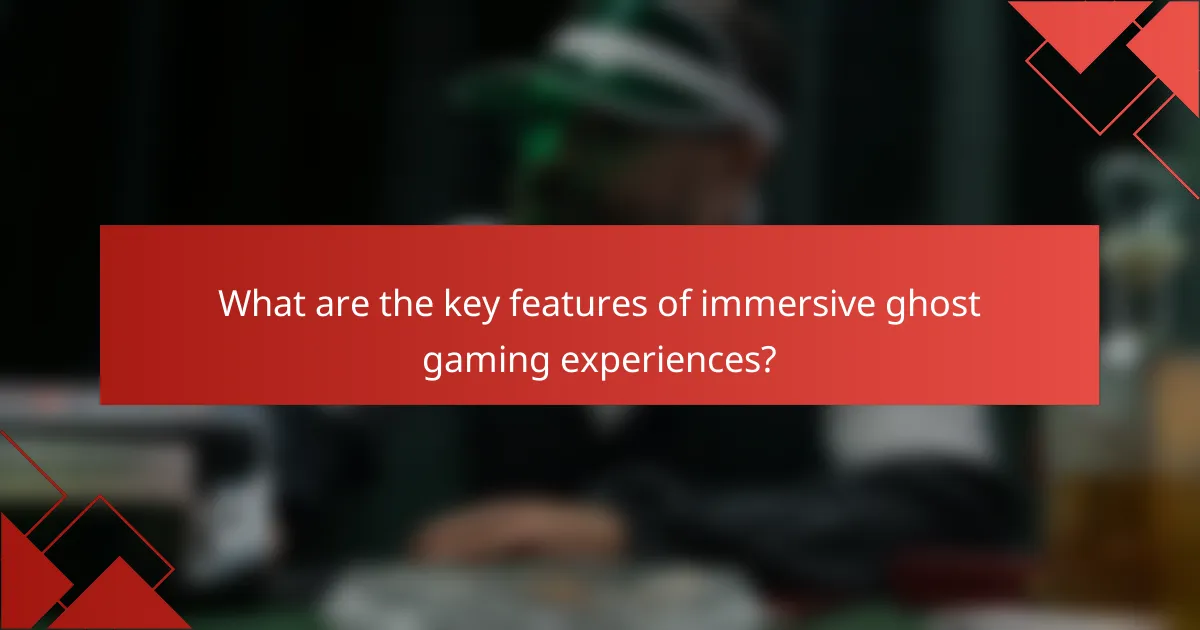
What are the key features of immersive ghost gaming experiences?
Immersive ghost gaming experiences combine advanced technology with sensory engagement to create thrilling environments where players can interact with supernatural elements. Key features include multiplayer interactions, dynamic storytelling, and environmental interactivity, all designed to enhance the player’s sense of presence and involvement.
Multiplayer interactions
Multiplayer interactions in ghost games allow players to collaborate or compete in real-time, enhancing the overall experience. Players can share discoveries, strategize together, or even engage in ghost hunting as a team, which adds layers of excitement and social engagement.
These interactions often utilize voice chat and gesture recognition, making communication feel natural and immersive. For instance, players might need to coordinate their actions to solve puzzles or escape from a ghostly entity, creating a shared sense of urgency.
Dynamic storytelling
Dynamic storytelling is a hallmark of immersive ghost gaming, where narratives adapt based on player choices and actions. This feature allows for multiple endings and varied experiences, ensuring that no two playthroughs are the same.
Players might uncover different plotlines depending on their interactions with the environment or other characters, enhancing replayability. For example, a player’s decision to investigate a specific location could lead to a unique ghost encounter or reveal hidden lore about the game’s universe.
Environmental interactivity
Environmental interactivity refers to the ability of players to manipulate and engage with their surroundings in meaningful ways. In ghost games, this can include opening doors, moving objects, or activating devices that trigger ghostly phenomena.
This feature not only heightens immersion but also encourages exploration and experimentation. Players might need to search for clues or tools hidden within the environment, making their interactions feel impactful and integral to the gameplay experience.
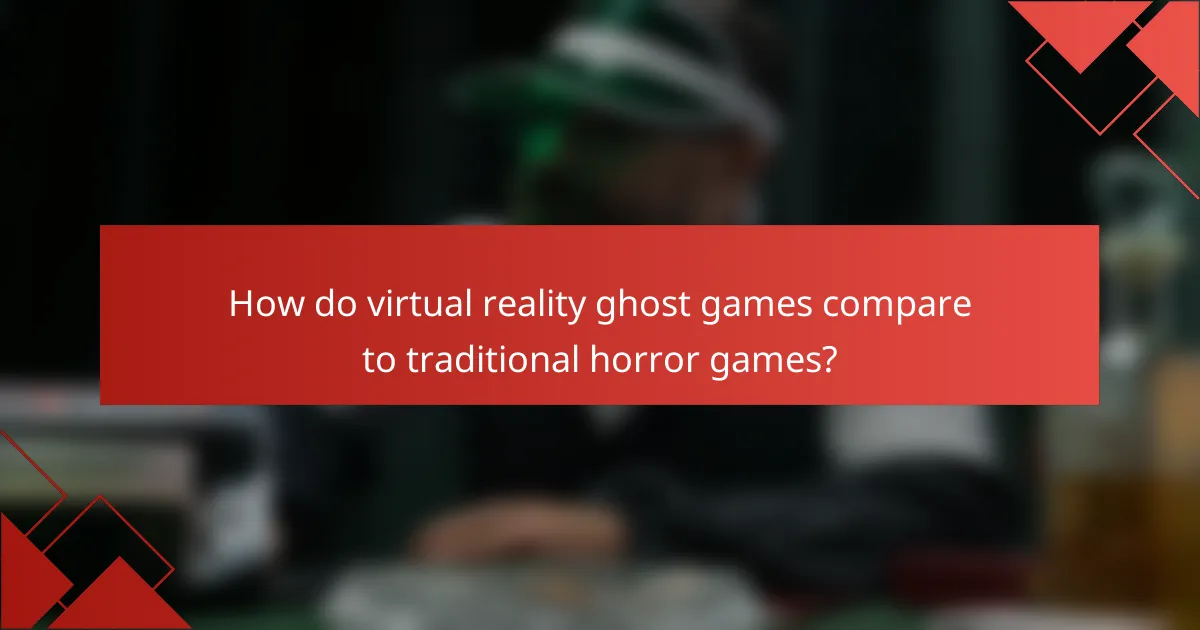
How do virtual reality ghost games compare to traditional horror games?
Virtual reality ghost games offer a more immersive experience than traditional horror games by placing players directly into the environment, enhancing emotional engagement and sensory interaction. This shift in gameplay mechanics allows for a heightened sense of fear and realism that is often lacking in conventional formats.
Increased immersion
In virtual reality ghost games, players are fully surrounded by the game world, which significantly enhances immersion. Unlike traditional horror games, where players view the action from a distance, VR places them in the center of the experience, making every sound and movement feel immediate and personal.
This level of immersion can lead to stronger emotional responses. For example, players may physically react to in-game stimuli, such as jumping at sudden scares or feeling a chill during eerie moments, creating a more intense horror experience.
Physical presence
Physical presence in virtual reality ghost games is achieved through the use of motion tracking and haptic feedback, allowing players to interact with the environment in a tangible way. This technology enables users to reach out and touch objects, enhancing the sense of reality and involvement.
For instance, players can pick up virtual items or navigate through dark hallways, which can amplify feelings of vulnerability and tension. However, it’s important to ensure a safe play area to avoid accidents while moving around, as the immersive nature can lead to disorientation in real-world spaces.
